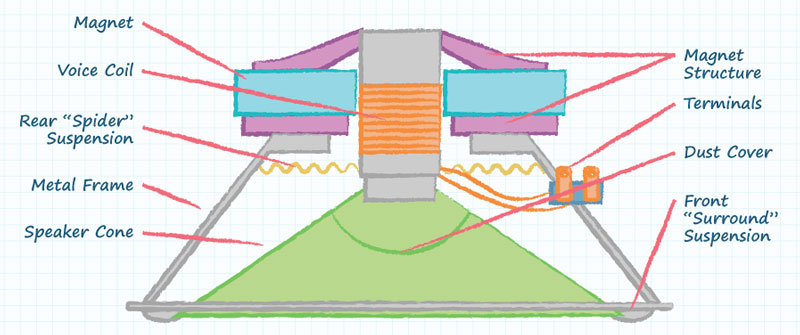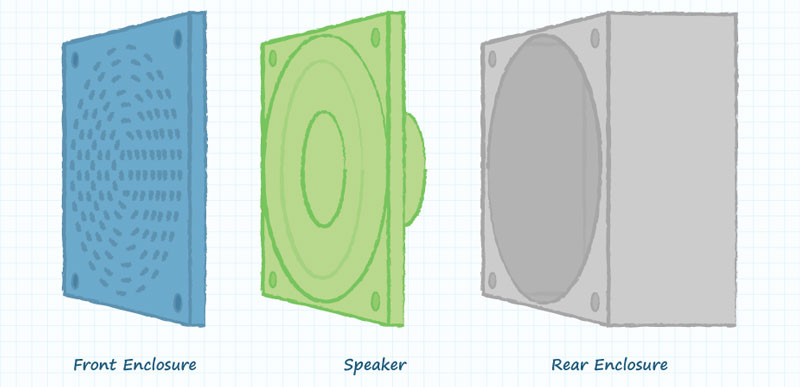How to design with mini speakers for the best sound and reliability
Miniature speakers can be designed into a wide range of devices including door-entry systems, small timers or alarms, and various types of handheld and portable audio products. They can also be used to enhance the Human-Machine Interface (HMI) of equipment like industrial machinery, medical devices, computer peripherals, office automation and others.
By: Bruce Rose, Principal Applications Engineer, CUI Devices
Miniature speakers are available in various types, covering input-power ratings from 0.1-6.0W, standard 8, 6 or 4Ω impedances, circular, rectangular or square frames from 10-40mm, and depths as low as 2mm.
Other choices include conventional wire connections, or surface-mount speakers that are compatible with high volume manufacturing processes and capable of withstanding reflow-soldering temperatures.
Conventional micro speaker construction

Figure 1. Miniature electromagnetic speaker construction
As conventional electromagnetic speakers, they are constructed as shown in figure 1. The paper or Mylar cone is held by front and rear suspension mechanisms and attached to a voice coil suspended in the field of a fixed permanent magnet.
The front suspension is attached to a speaker frame, which in turn is attached to the magnet structure. When an audio signal is applied to the voice coil, the cone moves relative to the rest of the assembly and generates pressure waves that are detected as sound.
A housing is needed to hold the speaker securely and protect the mechanism against physical damage. This is typically comprised of front and rear enclosures that are clamped on either side of the speaker and its mounting frame, as shown in figure 2.
In practice, this could be a simple cut-out in the front panel of a piece of equipment, or a molded or machined recess fitted with a front panel. In any case, taking care over the design of the housing - including geometry and construction - can contribute to maximising the audio performance and overall device ruggedness.

Figure 2. High quality mechanical construction can enhance ruggedness and audio performance
Designing speaker enclosures
The front cavity must allow sound waves to propagate from the speaker, without excessively attenuating the volume. This can be achieved by creating a hole pattern in the front plate. Removing as little as 20% of the material can provide a good compromise between protection and loudness. The sound waves can propagate most efficiently if the size and shape of the array are roughly equivalent to those of the speaker.
When designing the front cavity, it is important to ensure that the speaker cone can reach its maximum excursion without contacting the front panel. A gap of 1-2mm between the cone and front panel is usually adequate.
An experienced audio designer can also optimise the rear cavity to enhance the speaker volume and audio quality. However, this is difficult to achieve without specialised knowledge on the subject. A simple sealed cavity of suitable size, lined with sound-absorbing material, can perform sufficiently well. The walls of the cavity also need to be rigid enough so as not to radiate sound.
For best audio performance, the rear cavity should have a large capacity to prevent movement of the speaker diaphragm from significantly changing the air pressure in the rear enclosure and hence attenuating the sound radiated from the front of the speaker. On the other hand, recognising that a miniature speaker is often chosen to help meet tight space constraints, the maximum capacity could be severely limited.
A good starting point is to make the depth of the rear cavity approximately equal to the speaker diameter. If the cavity depth needs to be reduced to achieve a lower product profile, it may be possible to extend the projected area behind the speaker to maximise the cavity’s capacity.
It is also important to prevent sound propagating from the rear cavity to the front of the speaker. This can be achieved by ensuring the speaker frame is tightly sealed. The speaker should also be mounted securely to prevent unwanted vibrations or rattling. Inserting high density foam at the interface between the speaker frame and the enclosure can help to satisfy both of these requirements.
There are certainly several factors to consider when designing a speaker enclosure, but by following these simple design guidelines one can achieve the best sound possible for their space-constrained application when utilising micro speakers.
Additional resources
View more information on miniature speakers of various shapes, sizes and power ratings from CUI Devices, to suit your application.
Read more about speaker design and applications in CUI Devices' Speakers Product Spotlight.


